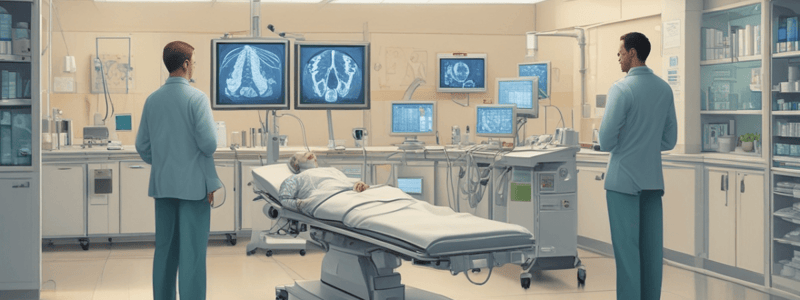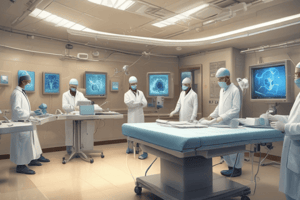Podcast
Questions and Answers
What is a major advantage of chest radiographs compared to computed tomography (CT)?
What is a major advantage of chest radiographs compared to computed tomography (CT)?
- CT provides higher spatial resolution.
- CT is cheaper than chest radiographs.
- Chest radiographs can be performed at the bedside. (correct)
- Radiographs use less radiation than CT. (correct)
Which aspect of imaging is a disadvantage of using computed tomography (CT)?
Which aspect of imaging is a disadvantage of using computed tomography (CT)?
- It is less expensive than chest radiographs.
- It requires patient transportation to the machine. (correct)
- It offers less detail than X-ray.
- It uses less radiation than standard X-rays.
In what way does computed tomography (CT) offer an advantage over traditional X-rays?
In what way does computed tomography (CT) offer an advantage over traditional X-rays?
- CT can be performed more quickly than X-rays.
- It utilizes a lower radiation dose.
- CT requires less patient cooperation.
- It provides greater detail of anatomical structures. (correct)
How many chest radiographs are performed annually in the US?
How many chest radiographs are performed annually in the US?
What primary purpose do X-rays serve in medical imaging?
What primary purpose do X-rays serve in medical imaging?
Which of the following is a characteristic of computed tomography (CT) imaging?
Which of the following is a characteristic of computed tomography (CT) imaging?
What is a common diagnostic limitation of chest radiographs?
What is a common diagnostic limitation of chest radiographs?
Which factor contributes to the popularity of chest radiographs in medical practice?
Which factor contributes to the popularity of chest radiographs in medical practice?
Which anatomical structures are included in a chest X-ray?
Which anatomical structures are included in a chest X-ray?
What is the primary function of a chest X-ray in an acute setting?
What is the primary function of a chest X-ray in an acute setting?
How does the opacity of structures differ in a chest X-ray?
How does the opacity of structures differ in a chest X-ray?
Which of the following is NOT a typical use for chest computed tomography (CT)?
Which of the following is NOT a typical use for chest computed tomography (CT)?
What advantage does intravenous iodinated contrast provide during a chest CT?
What advantage does intravenous iodinated contrast provide during a chest CT?
During chest CT imaging, which of the following structures can be visualized in detail?
During chest CT imaging, which of the following structures can be visualized in detail?
What appears darker on a chest X-ray compared to other structures?
What appears darker on a chest X-ray compared to other structures?
Which of the following statements about the opacity in radiography is true?
Which of the following statements about the opacity in radiography is true?
What is one of the key advantages of using a Chest Radiograph (CXR) over a CT scan for patients with shortness of breath in the emergency room?
What is one of the key advantages of using a Chest Radiograph (CXR) over a CT scan for patients with shortness of breath in the emergency room?
Which anatomical markers are essential to identify when reading a Chest Radiograph?
Which anatomical markers are essential to identify when reading a Chest Radiograph?
In which scenario is a CT scan generally considered superior to a Chest Radiograph?
In which scenario is a CT scan generally considered superior to a Chest Radiograph?
Which major abdominal organ is NOT typically identified on abdominal X-ray?
Which major abdominal organ is NOT typically identified on abdominal X-ray?
When performing an abdominal CT scan, what are the two types of contrast that may be used?
When performing an abdominal CT scan, what are the two types of contrast that may be used?
Which statement best describes the advantages of Ultrasound compared to CT in the context of screening for abdominal trauma?
Which statement best describes the advantages of Ultrasound compared to CT in the context of screening for abdominal trauma?
What is one of the limitations of using a Chest Radiograph compared to a CT scan?
What is one of the limitations of using a Chest Radiograph compared to a CT scan?
What instructional method is employed for this imaging session?
What instructional method is employed for this imaging session?
What is a key advantage of bedside chest radiographs in acutely ill patients?
What is a key advantage of bedside chest radiographs in acutely ill patients?
Which imaging technique is most accurate for diagnosing pulmonary embolism?
Which imaging technique is most accurate for diagnosing pulmonary embolism?
What is one disadvantage of bedside chest radiographs?
What is one disadvantage of bedside chest radiographs?
What is the primary use of a focused Ultrasound exam (FAST) in trauma cases?
What is the primary use of a focused Ultrasound exam (FAST) in trauma cases?
Which imaging technique provides the most detail regarding organ injury in abdominal trauma?
Which imaging technique provides the most detail regarding organ injury in abdominal trauma?
What is a potential drawback of using CT scans?
What is a potential drawback of using CT scans?
In the context of organ injury from a Motor Vehicle Collision (MVC), when is a CT scan preferred?
In the context of organ injury from a Motor Vehicle Collision (MVC), when is a CT scan preferred?
What limitation does Ultrasound have in evaluating abdominal trauma?
What limitation does Ultrasound have in evaluating abdominal trauma?
What is a primary use of chest CT scans in an acute setting?
What is a primary use of chest CT scans in an acute setting?
What advantage does CT have over Chest X-ray in lung cancer detection?
What advantage does CT have over Chest X-ray in lung cancer detection?
Which anatomical structure is well visualized on abdominal radiographs?
Which anatomical structure is well visualized on abdominal radiographs?
What condition can abdominal radiographs help diagnose in an acute situation?
What condition can abdominal radiographs help diagnose in an acute situation?
In which situation is CT preferred over abdominal radiographs for evaluation?
In which situation is CT preferred over abdominal radiographs for evaluation?
Which imaging modality is most effective in demonstrating detailed anatomy of all abdominal viscera?
Which imaging modality is most effective in demonstrating detailed anatomy of all abdominal viscera?
What can be identified on an abdominal radiograph during small bowel obstruction?
What can be identified on an abdominal radiograph during small bowel obstruction?
What condition is NOT typically evaluated using a CT scan?
What condition is NOT typically evaluated using a CT scan?
Flashcards are hidden until you start studying
Study Notes
Instructional Overview
- Block titled "Foundations" directed by James Proffitt, PhD.
- Offered on July 31, 2024, from 1:00 pm to 3:00 pm.
- Instructors: William Rappaport, MD (Surgery) and Stephane Chartier, DO (Medical Imaging).
- Uses team-based learning (TBL) and flipped classroom instructional methods.
Learning Objectives
- Explain CXR advantages over CT for patients with shortness of breath.
- Basic skills for reading CXR and identifying anatomical markers.
- Situations where CT is more effective than CXR.
- Identify major abdominal organs on XR.
- Recognize liver, spleen, pancreas, kidney, stomach, and colon on CT with contrast.
- Compare advantages and disadvantages of Ultrasound (US) and CT for abdominal trauma screening.
Radiography vs. Computed Tomography (CT)
- Each year, about 80 million chest radiographs are performed in the US.
- Chest X-rays are cost-effective, low in radiation, and quick to perform, including portable options.
- X-ray technique involves penetrating radiation creating images based on density differences of tissues.
- CT provides cross-sectional images, offering higher spatial resolution and details of anatomy with more radiation exposure.
Chest Radiography
- Key anatomical structures visualized: trachea, lungs, heart, aorta, and ribs.
- Opacity dynamics: air appears black, bones appear white; lung conditions can alter this balance.
- Common acute uses include identifying rib fractures, pneumothorax, pneumonia, and pleural effusions.
Chest Computed Tomography (CT)
- Can utilize iodinated contrast to reveal vascular issues (e.g., pulmonary embolism).
- Detailed views of the tracheobronchial tree, heart chambers, and lungs are available.
- Acute uses: diagnosing pulmonary embolism, aortic dissection, trauma injuries, etc.
- Better for lung cancer screening due to higher sensitivity in detecting smaller tumors.
Abdominal Radiographs
- Identifiable structures include the liver, bowel loops, and kidneys.
- Noted limitations in visualizing viscera; other imaging (US, CT, MRI) preferred for detailed intrabdominal assessment.
- Useful for diagnosing pneumoperitoneum, renal stones, and bowel obstructions.
Abdominal CT
- Provides comprehensive views of all abdominal organs and better details in trauma cases.
- Focused Ultrasound (FAST) can evaluate hemoperitoneum in acute trauma but may not specify the bleeding source.
- US offers rapid bedside evaluation with no radiation, but CT is superior for identifying organ injuries and active bleeding.
Summary of CT vs. Chest X-ray in Trauma Settings
- Bedside chest radiographs prioritize patient stability and lower radiation but lack three-dimensional context.
- CT, though more costly and requires transportation, offers critical diagnoses for conditions undetectable by X-ray.
- In trauma cases, CT also effectively guides treatment decisions based on detailed injury localization.
Studying That Suits You
Use AI to generate personalized quizzes and flashcards to suit your learning preferences.




